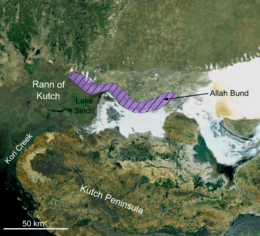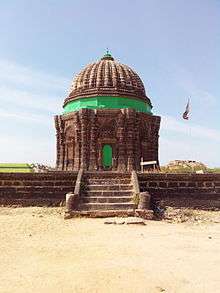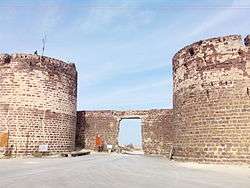Lakhpat
| Lakhpat લખપત | |
|---|---|
| Town | |
|
Lakhpat fort gate | |
 Lakhpat  Lakhpat Location in Gujarat, India | |
| Coordinates: 23°49′N 68°46′E / 23.82°N 68.77°ECoordinates: 23°49′N 68°46′E / 23.82°N 68.77°E | |
| Country |
|
| State | Gujarat |
| District | Kachchh |
| Elevation | 89 m (292 ft) |
| Population (2011) | |
| • Total | 807 |
| Languages | |
| • Official | Gujarati, Hindi |
| Time zone | IST (UTC+5:30) |
| Telephone code | 02839 |
| Vehicle registration | GJ-12 |
| Coastline | 10 kilometres (6.2 mi) |
| Nearest Town | Nakhatrana |
| Lok Sabha constituency | Bhuj |
| Climate | Dry (Köppen) |
| Avg. summer temperature | 42 °C (108 °F) |
| Avg. winter temperature | 20 °C (68 °F) |
| Website |
gujaratindia |
Lakhpat is a sparsely populated town and sub-district in Kachchh district in the Indian state of Gujarat located at the mouth of Kori Creek. The town is enclosed by 7km long 18th-century fort walls.
Etymology
The town is named after Rao Lakha who ruled in Sindh about the middle of the thirteenth century.[1]
History


Historically it has been very important trading post connecting Gujarat to Sindh. The waters of Sindhu river used to flow into Lakhpat and further onto Desalpar Gunthli. Within historic times Lakhpat has had only one very short period of prosperity. Rice used to be cultivated and Lakhpat used to give an annual revenue of 800,000 Koris just from rice. It is also said that Lakhpat used to generate an income of 100,000 Koris everyday from maritime activities. Fateh Muhammad, about the close of the eighteenth century (1801), enlarged and rebuilt its wall, and here for a time great part of the trade of Sindh centred. Though he thought it one of the chief supports of his power, Lakhpat declared against Fateh Muhammad when he opposed the Rao of Cutch State in 1804. A few years later (1809), the commandant of the fort, Mohim Miyan, drove out the agents of Hansraj and governed the town on his own accounts. In 1818 Lakhpat had 15,000 people and yielded a yearly revenue of £6000 (₹ 60,000). After the earthquake of 1819 a natural dam known as the Allahbund was formed, Indus river changed its course of flow and started flowing into the Arabian sea further north.[2] Thus Lakhpat lost its importance as a port. By 1820, the population reduced to 6000 inhabitants, consisting chiefly of mercantile speculators from other countries and families of Hindus driven from Sindh. The walls were in good repair, but the houses were ruined and did not fill one-third of the area. In 1851 all trade had left the town, and it has since remained poverty-stricken and half deserted. The population reduced to 2500 by 1880.[3]
Today it is sparsely populated ghost town, a city of ruins of buildings and a magnificent fort surrounding them. The population was 463 in 87 households 2001[4] which increased to 566 in 108 households in 2011.
During the period of Muslim invasion, the Khudabadi Sonara community and other Hindus who had not converted to Islam under the Ghaznavids moved to Vighokot and Lakhpat around 1028 AD, to avoid genocide at the hands of the invading Muslims and to live peacefully under Hindu Samma rulers.
Places of Interest
Fort
The fort rebuilt and expanded in 1801 by Fateh Muhammad is an irregular polygon, defended by round towers and built of hard brown stone. The 7 km long walls are of considerable height but not thick.[3]
Pir Ghaus Muhammad tomb

Pir Ghaus Muhammad, a Sufi saint and Syyed of Lakhpat, half-Muslim and half- Hindu in his customs, who was believed to have supernatural power. Dying in 1855, his brother Bava Mia or Sa Saheb, from contributions made by Gosh Muhammad's followers, began to build a tomb locally known as Kubo. This tomb, of black stone, on a platform fifty-four feet square and seven high, rising in a conical dome 63 feet 3 inches high, is octagonal in shape, with four side doors arched and richly carved, and the walls decorated with patterns of flowers and leaves. Inside, the floor is paved with white and black marble, and the grave is covered with a white marble canopy. On the walls are passages from the Quran. It is still unfinished. The water tank opposite the tomb is believed to have healing characteristics for skin diseases.[3]
Lakhpat Gurudwara Sahib

Lakhpat Gurudwara Sahib is a Gurudwara, a place of worship for the Sikhs. It is believed that Guru Nanak on his way to Mecca for Haj stayed over here. This Gurdwara have his relics like footwear and palkhi. They are worshiped by the Udasi Sect. The Gurudwara is declared a protected monument by the state archeological department and has won the UNESCO award for restoration after the earthquake.[5][6][7][8][9]
Other
Sayyed Pir Shah Dargah has nine-domed with intricate carvings. Nani Mai Dargah, Hatkeshwar Temple amongst others in the old town are reminisces of the past.
BSF Post
The seaward side of the fort is guarded by Border Security Force (BSF) of India soldiers as it is not far away from international border between India and Pakistan marked in salt marsh land. There are BSF guards posted on the fort's fortifications and the nearby Border Outpost.[10][11][12][13]
In popular culture
- The 2000 Hindi film Refugee directed by J P Dutta featured Lakhpat fort as a fictitious town located across the international border in neighboring Pakistan.
References
- ↑ Gazetteer of the Bombay Presidency: Cutch, Palanpur, and Mahi Kantha. Printed at the Government Central Press. 1880. p. 232-233.
- ↑ "BELIEVE IT OR NOT! INDUS WATER MIXES WITH NAL SAROVAR".
- 1 2 3 Gazetteer of the Bombay Presidency: Cutch, Palanpur, and Mahi Kantha. Printed at the Government Central Press. 1880. pp. 232–233.
- ↑ "View Population". Office of the Registrar General & Census Commissioner, India. Retrieved 25 March 2012.
- ↑ BOTTOMLINE - THE AWARD COMES AS A GIFT FOR LOCAL RESIDENTS, NONE OF THEM SIKH, WHO PARTICIPATED IN THE RESTORATION PROJECT. Stone by stone, they restored gurudwara to bag UNESCO award; by Rupam Jain Nair; 9 September 2004; The Indian Express
- ↑ A gurdwara in no man's land; With Sunil Raghu in Lakhpat; 3 January 2006; CNN-IBN
- ↑ Google Book Review: History of Sikh Gurus Retold: 1469-1606 C.E; By Surjit Singh Gandhi; Published by Atlantic Publishers and Distributors (P) Ltd.; ISBN 978-81-269-0859-2
- ↑ Gurudwara Pehli Patshahi (Lakhpat); Gateway to Sikhism. Also posted at
- ↑ A year of cycling across India to save youth from drugs; 31 January 2009; IANS; Bombay News.Net. Also posyed at
- ↑ Rann of Kutch terrain comes in way of fast border fencing; 7 December 2009; Times of India
- ↑ Concrete road in Sir Creek to help BSF in patrolling; by Roxy Gagdekar; 1 August 2009; DNA india
- ↑ Drawing a line in the sand; Janyala Sreenivas; 17 April 2005; Indian Express Newspaper
- ↑ Lakhpat heard there was a war, knows little else; by Dharmendrasinh Chavda; 28 August 1999; The Indian Express
- The article incorporates the Public Domain text from Gazetteer of the Bombay Presidency: Cutch, Palanpur, and Mahi Kantha. Printed at the Government Central Press. 1880. p. 232-233.
- The quaint charm of Rann of Kutch; by P.Devarajan; 27 January 2000; Business Line, Financial Daily from THE HINDU group of publications
External links
| Wikimedia Commons has media related to Lakhpat Fort. |
- Lakhpat on Gujarat Tourism department website
- Between sun and superstition; 11 August 1999; EXPRESS NEWS SERVICE; The Indian Express
- Border villagers set to get I-card; by Hiral Dave; 16 June 2009; The Indian Express
